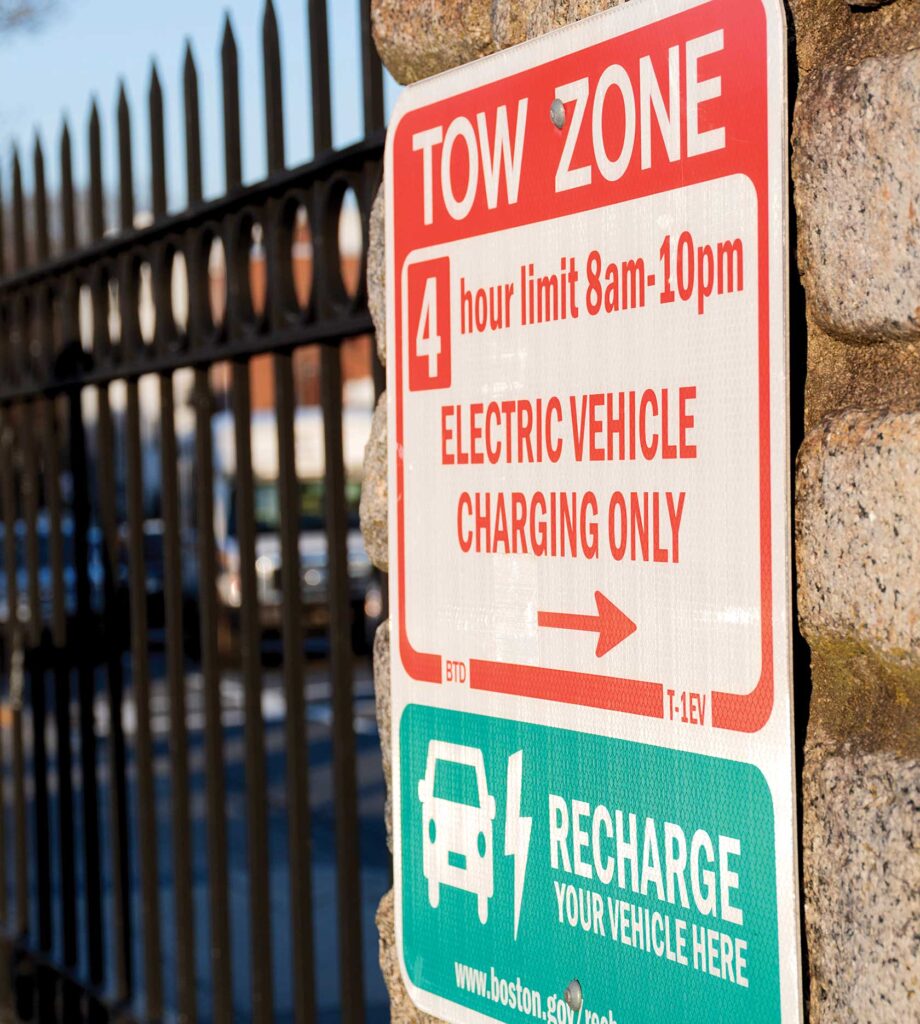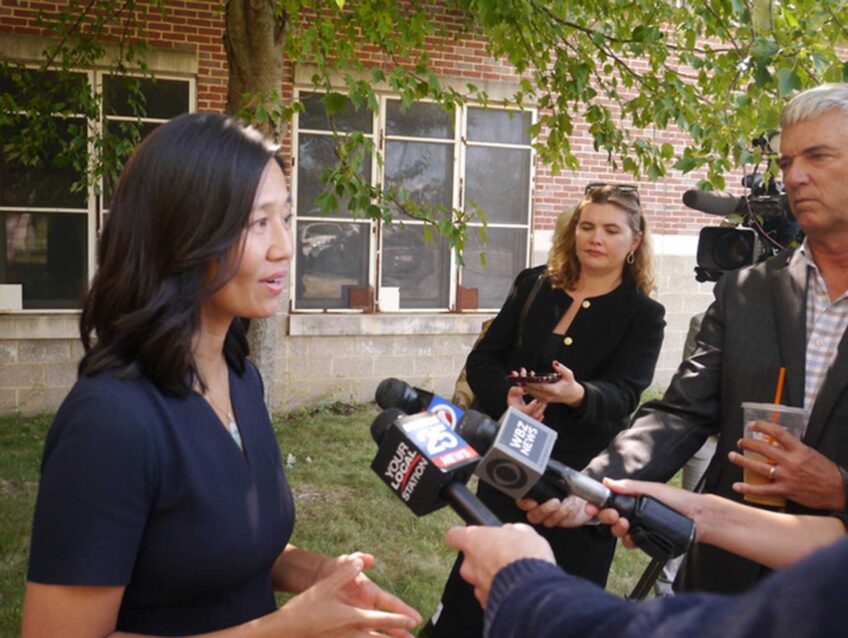‘Trucks, buses, vans, oh my’: Larger vehicles are focus of state’s new EV report

A new state report identified goals around how and where to increase Massachusetts’ electric vehicle charging infrastructure.
That document, the second biennial assessment from the state’s Electric Vehicle Infrastructure Coordinating Council, was released Aug. 12 and focused on introducing more infrastructure for larger electric vehicles and expanding a charging network to parts of the state, like in the central and western regions, that currently have limited access.
Along with the assessment, the Massachusetts Department of Environmental Protection announced $46 million in allocations through the 2027 fiscal year to take a stab at some of those goals.
“Our goal with the funding side is simple: It’s to take this EVICC assessment and start making it happen,” said MassDEP Commissioner Bonnie Heiple.
The assessment and new funding have a focus on expanding infrastructure for charging medium- and heavy-duty electric vehicles — everything from local delivery trucks and shuttles to buses and freight trucks.
“We know that these are the most polluting vehicles on our roads,” Heiple said. “This is the diesel smog; this is the particulate.”
When it comes to reducing transportation emissions, tackling those larger vehicles could make a dent. According to a report from the Union of Concerned Scientists, published in February, across the country medium- and high-duty vehicles make up about 13% of vehicles on the road, but account for about 30% of climate warming emissions. That report identified medium- and heavy-duty vehicles as the largest source of nitrogen oxides, one kind of greenhouse gas.
State officials said they hope the emissions reductions that will come with electrifying those larger vehicles will especially benefit communities of color and other environmental justice communities, which are exposed to toxic air at a higher rate.
A 2021 article in the journal Geophysical Research Letters, found that low-income communities of color in the United States are exposed to 28% nitrogen dioxide, which can lead to cardiovascular disease, asthma and other respiratory ailments, compared to their wealthier white counterparts.
In Boston, neighborhoods like Nubian Square have a history of standing up against air pollution from a high quantity of diesel-powered buses.
For Massachusetts, those gains represent an important step toward reaching state-established goals for vehicle electrification. The state’s Clean Energy and Climate Plans for 2030 and 2050 established a goal of reducing transportation emissions of 34% below 1990 by the end of the decade and by 86% by 2050.
The report “gets a lot right,” said Samantha Houston, a senior manager for the Union of Concerned Scientists Clean Transportation program, pointing to elements like the focus on medium- and heavy-duty chargers, as well as the shifts in the electrical grid that will be required and a focus on best practices surrounding equity.
The focus on increasing charging infrastructure for larger vehicles stems from concerns the state heard around its efforts to push for the switch to electric medium- and heavy-duty electric vehicles, Heiple said.
“That was largely premised on the notion that there’s no charging for these vehicles,” Heiple said. “How can you force a switch when states are not ready in terms of the infrastructure that you’ve built out? So we’re being really thoughtful about that in Massachusetts.”
Of the total $46 million in DEP funding announced by the state, $30 million is slated to go toward supporting charging infrastructure for medium- and heavy-duty vehicles, alongside chargers on secondary corridors — high-traffic roadways that are not already covered by other state plans for electrification.
The remaining $16 million will support the installation of EV chargers through the state’s electric vehicle incentive program through the DEP. That program supports installation of charging stations, including costs like buying the infrastructure and the labor required to install it.
Previously, the program supported the installation of chargers at locations like school campuses, at multi-unit housing complexes and workplaces.
Houston said charging for larger vehicles is, in many ways, similar to charging so-called “light vehicles” — think a personal car — though some elements like the energy needs differ. According to the Great Plains Institute, a nonprofit working on accelerating the transition to net-zero emissions, medium- to heavy-duty electric vehicles can use 0.5 kWh to 5.2 kWh per mile. Light-duty EVs use 0.2 to 0.4 kWh per mile.
That greater energy usage means bigger batteries that can cost more and require longer charge times.
Like personal electric vehicles, medium- and heavy-duty EVs can charge “at home,” wherever they sit overnight — for example at a truck depot — as well as at truck stops along their routes. But Houston said that vehicles like trucks might have additional moments to charge, like when they’re loading and unloading.
The assessment also identified a need to expand the deployment of EV chargers — it estimated that the state needs to triple its pace — even as across the country the expansion of electric vehicles faces backlash from the federal government under the Trump administration, which is set to end federal tax credits for new electric vehicle purchases through its budget reconciliation act, formerly called the One Big Beautiful Bill.
And, in February, the administration froze funding for the federal National Electric Vehicle Infrastructure program, which provides money to states to install chargers. A coalition of about a dozen states sued in response, and on Aug. 15, the administration reopened the program.
But the report was heartening, Houston said, as an indicator of continued state support, even as the federal government pulls back on electric vehicles.
“That’s not what we wanted to see, especially in this moment, when we had started to see some acceleration of progress on those fronts — progress which, I should say, we desperately need to address global warming as well as local air pollution issues,” Houston said.
State officials dismissed the federal pullback on electric vehicles.
“We have solid science on this; we know about the threats to public health from pollutants emitted from the transportation sector; we have a way to address it,” Heiple said. “To ignore this entire market sector, to basically attempt to put it on ice and just roll back the clock and roll back the standards to earlier times that have gotten us in a really bad situation, is tremendously unhelpful.”
While the reduction in federal support may slow the uptake of vehicles and the installation of charging infrastructure, Houston said she doesn’t expect to see action around electric vehicles stop fully.
“It really is devastating to see the brakes being put on this progress at the federal level, but it’s a global market,” Houston said. “And action from states like Massachusetts can also help continue to move us forward.”
According to Cox Automotive, as of April, electric vehicle sales continued to grow in the first part of the year. In a market insight report for the first quarter of 2025, Cox reported the sale of nearly 300,000 electric vehicles. At the same time in 2024, Cox reported the sale of 268,909 new EVs.
“The fact that we’re continuing to see adoption at similar rates, I think, makes the point that … EVs are really here to stay,” said Josh Ryor, assistant secretary of energy for the Executive Office of Energy and Environmental Affairs and chair of the EVICC.
Actions by individual states, like the funding and report from Massachusetts’ EVICC, will also help support the profusion of EVs, she said.
The pullback could, however, complicate the state’s vehicle electrification goals, Houston said, even if it may not make it impossible.
State officials said that the federal shifts pose a challenge, but don’t change the state’s goals.
“The pullback on these policies certainly doesn’t help,” Ryor said. “But we are committed to really making sure that we are focused on what we can control, having the biggest impact we can and making sure that our dollars are going as far as possible.”
Houston said that if a federal pullback keeps Massachusetts from meeting its electrification goals, any benefits around climate and emissions will still be worthwhile.
“If we miss them by a hair, you know, all that progress we made still goes a long way to reducing greenhouse gas emissions and contributing to reducing local air pollution,” Houston said.




